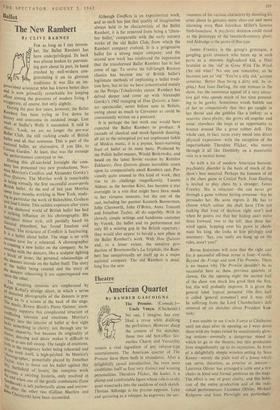Batllet
The New Rambert
By CLIVE BARNES FOR as long as I can remem- ber, the Ballet Rambert has been underprivileged. Its back was almost broken by patronis- ing pats about its past, its hand crushed by well-wishers con- gratulating it on its glorious traditions. It was like an im- Poverished aristocrat who has known better days and is now primarily remarkable for keeping alloat among the pressures of modern living. 1 exaggerate, of course, but only slightly. boring the past few years, however, the Ballet ainbert has been trying to live down its history and overcome its outdated image. Last Week at Sadler's Wells it succeeded. It said in effect: 'Look, we are no longer the pre-war Ballet Club, the still rocking cradle of British ballet and all that nonsense. This is part of the ,Ilational ballet, an alternative, if you like, to '-nvent Garden.' At least, that was the message the performances conveyed to me. „,,buring this all-too-brief fortnight the com- P4nY has presented two new productions, Nor- intsan Morrice's Conflicts and Alexander Gorsky's Quixote. The Morrice work is remarkable ln being virtually the first successful avant-garde British ballet. At the end of last year Morrice Ghent four months working in New York, study- g in particular the work of Balanchine, Graham and Jose Limon. This sudden exposure after years in the sheltered world of British ballet has had istriking influence on his choreography. His „a,dividual dance style, still partially based on `tassical precedent has found freedom and ItilerleY. The structure of Conflicts is fascinating. is a ballet about ballet. The stage is set with Sreless care for a rehearsal. A choreographer w creating a new ballet on the company. As he restles with the dancers, like a sculptor fighting b, hInd( of stone, the personal relationships of (Ile dancers intrude on the ballet itself. The story the ballet being created and the story of the II dancers rehearsing it are superimposed one P°11 the other. The ka, resulting tensions are emphasised by of Koltai's strange decor, in which a series jeetwstorted photographs of the dancers is pro- ed on to a screen at the back of the stage. trues. music, &nest Bloch's Piano Quintet, unob- trusively supports this complicated structure of jeur icting interests and emotions. Morrice's 14ekheY into the interior of ballet at first sight her: something in clarity, not through any in- thent obscurity, but because its originality of takeuie, dancing and decor makes it difficult to both in at one fell swoop. The tangle of emotions, in() in the imaginary ballet being rehearsed and `chore work itself, is high-pitched. As Morrice's Taylor graPher,' powerfully played by Jonathan tiny battlefield tries to force out his ballet against this hhattl nerar eld of lovers, the complete work e e a swirling hysteria, only resolved at Sandnbu when one of the gentle combatants (June in, 0k) is left pathetically alone and sorrow- Jo;,aChesworth) the other two (Gillian Martlew and have been reconciled. Although Conflicts is an experimental work, and as such has just that quality of imagination always held to be characteristic of the Ballet Rambert, it is far removed from being a 'cham- ber ballet,' comparable with the early nursery works of the old Ballet Club, from which the Rambert company evolved. 11 is a progressive ballet for a strong major company, and the second new work has reinforced the impression that the transformed Ballet Rambert has at last come of age. To revive the full-length Russian classics has become one of British ballet's legitimate methods of implanting a ballet tradi- tion here, but so far we have concentrated mainly on the Petipa/Tchaikovsky canon. Rambert has delved deeper and come up with Alexander Gorsky's 1902 restaging of Don Quixote, a four- act spectacular, never before seen in Britain, owing about as much to Cervantes as could be conveniently written on a postcard.
It is perhaps the last work one would have expected the Ballet Rambert to produce. A cascade of classical and mock-Spanish dancing, all set to the uninspired yet not unpleasant tinkle of Minkus music, it is a joyous, heart-warming feast of ballet at its most basic. Produced by the Polish ballet-master, Witold Borkowsky, and based on the latest Soviet version by Rotislav Zakharov, Don Quixote places incredible strain upon its comparatively small Rambert cast. Pre- viously quite unused to this kind of work, they rise to its challenge magnificently. Lucette Aldous, as the heroine Kitri, has become a star overnight in a role that might have been made to her virtuoso measure, but the rest of the cast, including her partner Kenneth Bannerman, John Chesworth, John O'Brien, Anna Truscott and Jonathan Taylor, all do superbly. With its cleverly simple settings and handsome costumes by Voytek, the ballet and its performance not only fill a missing gap in the British repertory: they would also appear to herald a new phase in the Ballet Rambert's work. With Don Quixote and, to a lesser extent, the sensitive pro- duction of Bournonville's La Sylphide, the Ram- bert has unequivocally set itself up as a major national company. The old Rambert is dead; long live the new.






























 Previous page
Previous page